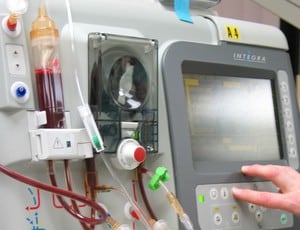Total intravenous anaesthesia

“This article explores why the practical and outcome benefits have made total intravenous anaesthesia an increasingly accepted alternative to use of inhalational agents” Joines and Harris (2021).
Peripheral IV catheter insertion service

“The peripheral vascular access service allowed patients to receive appropriate peripheral vascular access devices and avoid unnecessary peripheral catheter placements” Wells et al (2021).
IV infiltration and extravasation algorithm – Full Text

“To elaborate and validate the content and appearance of an algorithm for treating infiltration and extravasation of non-chemotherapy drugs and solutions administered to children” Santos et al (2021).
Infusion pump alerts and alarms impact clinical care

“Infusion pump alerts and alarms impact clinical care, as alerts and alarms by design interrupt clinical workflow” Yu et al (2021).
CLABSI reduction with 90-day sprint approach

“Using a 90-day sprint plan, numerous best practices were identified as key opportunities for CLABSI prevention and two main focus areas were identified for intervention: 1) daily chlorhexidine gluconate (CHG) bathing for all patients with central lines and 2) daily line necessity evaluation” Livingston (2021).
Blood culture initial specimen diversion technology

“Use of initial specimen diversion technology was associated with an 83% lower rate of blood culture contamination compared to conventional methods, sustained for 18 months” Brownfield and Peterson (2021).
Difficult central venous cannulation example

“We report a case of difficult central venous cannulation under general anesthesia with laryngeal mask airway in a young female child” Kumar et al (2021).
Intraosseous valproic acid administration – Full Text

“IO-delivered VPA is noninferior to intravenous administration and is a viable option in emergent situations when intravenous access is unattainable” Biesterveld et al (2021).
Topical essential black pepper oil and vein dilation

“We aimed to determine the effects of topical application of black pepper essential oil on peripheral intravenous catheter insertion success” Eren et al (2021).
Peripheral IV administration of 23.4 percent sodium chloride

“Peripheral venous administration of 23.4% NaCl is safe and achieves a reduction in ICP equivalent to that achieved by administration via central venous access” Faiver et al (2021).
Pediatric central venous catheter length

“Due to the difficulty in estimating the proper length of a central venous catheter in smaller pediatric patients, placing an 8 cm long catheter in these patients and then trimming the distal tip while on bypass may be the most accurate way to properly position a catheter” Glenski et al (2021).
How to calculate PICC length in newborns

“The catheter depth increased with every 100 g of weight gain and week of gestational age” Kim and Park (2021).
Difficult neonatal PICC removal – Full Text

“Here, we reported a case of an extremely preterm infant who underwent level 3 difficult removal of a PICC” Chen et al (2021).
Medical devices sterilised by Steril Milano – UK Alert

“Fraudulent activity by this third-party sterilisation provider has been identified. Multiple medical device manufacturers are affected. Manufacturers are advising customers of actions required to mitigate risks” MHRA (2021).
Persistent left superior vena cava in hemodialysis

“In this case report, we present a scenario where PLSVC was discovered after the placement of a tunneled HD catheter” Vyahalkar et al (2021).
Arterial cannulation in infants

“Scale ultrasound-guided radial arterial cannulation can significantly improved initial success rate and overall success rate, shorten puncture time in infant, compared with that achieved with the use of traditional ultrasound guidance” Yang et al (2021).
Vascular access competency tools

“Therefore, this study aimed to develop and validate three different tools for assessing competency in managing the care of short peripheral cannulas (SPCs), midlines, peripherally inserted central catheters (PICCs), centrally inserted central catheters (CICCs), and arterial catheters (ACs) (tool one), placing SPCs (tool two), placing PICCs and midlines (tool three)” Rigo et al (2021).
Candidemia and CVC combination outcome – Full Text

“Central venous catheter removal and appropriate initial antifungal treatment were associated with a lower incidence of the composite of mortality and recurrence. Additional studies are needed to determine the optimal duration of therapy following candidemia clearance” Junco et al (2021).
Double site intraosseous blood transfusion

“Dual anatomic site, pressure bag driven, intraosseous blood transfusion approximately doubles flow rates without evidence of clinical complications or hemolysis” Sulava et al (2021).
Improving infusion clinic wait times

“Exploring real-time data and using a classic quality improvement methodology allowed a Comprehensive Cancer Center to identify deficiencies and prevent delays in chemotherapy initiation” Hashemi-Sadraei et al (2021).
Extended use insulin infusion set

“Our analysis demonstrates that by extending the duration of infusion set wear, there may be substantial cost-savings by reducing insulin wastage” Kwa et al (2021).
Vascular access device chest-to-arm tunneling

“Our experience suggests that CTA tunneling is a safe maneuver, with very low risk of complications, and should be considered as an option in patients with complex venous access” Annetta et al (2021).
IV drug compatibility in critical care – Full Text

“Almost half of the mixtures simultaneously administrated was compatible, which indirectly reflects in the organized work between the nursing team and the clinical pharmaceutic in the discussions and decisions related to time scheduling” Garcia et al (2021).
CLABSI antibiotic treatment

“The limited data available suggests that shorter systemic antibiotic treatment duration may be sufficient for uncomplicated CRBSI” Muff et al (2021).
Bedside jugular vein access in children

“CVC of critically ill premature infants can be safely and successfully achieved in incubators using sonography guidance, protecting them from hypothermia and anesthetic drugs” Doğan et al (2021).
Ambulatory infusion clinic layout

“Our findings inform efforts to construct new and modify existing infusion centers to enhance patient safety and clinician communication” Fauer et al (2021).
Taurolidine lock solution for implantable port infection

“In our retrospective analysis, 2% taurolidine lock was completely safe and highly effective in the treatment of both catheter-colonization and catheter-related bloodstream infection in cancer patients with totally implanted venous access devices” Brescia et al (2021).
PICC in cancer patients – Full Text

“We aimed to evaluate the overall use of peripherally inserted central catheter (PICC) line in cancer patients, with the objective to study the demographic profile, complications, and safety related to PICC line in cancer patients” Sapkota et al (2021).
Extravasation detection device

“Significant differences (p = .006) in the pressure signal of the sensor could be observed when the catheter changed from the venous position to the extravasal position” Hinricher et al (2021).
CLABSI in medically complex children

“A target 0% CLABSI was possible in critically ill children without underling condition while a high incidence was reported in CMC and sustained by a peculiar CLABSI ecology” Scarselli et al (2021).

